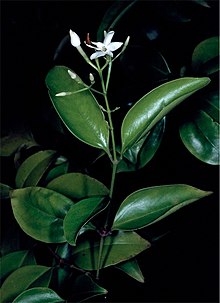Acronychia pauciflora
Acronychia pauciflora, commonly known as few-flowered acronychia or soft acronychia,[2] is a species of shrub or small tree that is endemic to eastern Australia. It has simple, egg-shaped leaves with the narrower end towards the base, greenish white flowers arranged in small groups, mostly in leaf axils and fleshy, more or less spherical fruit.
| Few-flowered acronychia | |
|---|---|
 | |
| Acronychia pauciflora in the Australian National Botanic Gardens | |
| Scientific classification | |
| Kingdom: | Plantae |
| Clade: | Tracheophytes |
| Clade: | Angiosperms |
| Clade: | Eudicots |
| Clade: | Rosids |
| Order: | Sapindales |
| Family: | Rutaceae |
| Genus: | Acronychia |
| Species: | A. pauciflora |
| Binomial name | |
| Acronychia pauciflora | |
Description
Acronychia pauciflora is a shrub or tree that typically grows to a height of 10 m (33 ft) and has wrinkled or finely scaly, creamy-fawn bark. The leaves are simple, 20–95 mm (0.79–3.74 in) long and 10–48 mm (0.39–1.89 in) wide on a petiole usually 4–14 mm (0.16–0.55 in) long. The flowers are arranged in small groups 8–12 mm (0.31–0.47 in) long, mainly in leaf axils, each flower on a pedicel 0.5–2 mm (0.020–0.079 in) long. The four sepals are about 1 mm (0.039 in) wide, the four greenish white petals 4–6 mm (0.16–0.24 in) long, and the eight stamens alternate in length. Flowering occurs from December to July and the fruit is a fleshy drupe 7–9 mm (0.28–0.35 in) long and more or less spherical.[2][3][4][5]
Taxonomy
Acronychia pauciflora was first formally described in 1946 by Cyril Tenison White in the Proceedings of the Royal Society of Queensland.[6][7]
Distribution and habitat
This acronychia grows between Broad Sound in central eastern Queensland, the Richmond River in north-eastern New South Wales and as far inland as the Carnarvon Range. It grows in rainforest and in brigalow (Acacia harpophylla) scrub from sea level to an altitude of 650 m (2,130 ft).[2][3]
Conservation status
This species is classified as of "least concern" under the Queensland Government Nature Conservation Act 1992.[8]
References
- "Acronychia pauciflora". Australian Plant Census. Retrieved 4 July 2020.
- Hartley, Thomas G.; Wilson, Annette J.G. (ed.) (2013). Flora of Australia (Volume 26). Canberra: Australian Biological Resources Study. p. 110. Retrieved 4 July 2020.CS1 maint: extra text: authors list (link)
- "Acronychia pauciflora". Australian National Botanic Gardens - Australian Tropical Rainforest Plants. Retrieved 4 July 2020.
- Hartley, Thomas G. (1974). "A revision of the genus Acronychia (Rutaceae)". Journal of the Arnold Arboretum. 55 (3): 493–495. Retrieved 4 July 2020.
- Richards, P.G.; Harden, Gwen J. "Acronychia pauciflora". Royal Botanic Garden Sydney. Retrieved 4 July 2020.
- "Acronychia pauciflora". APNI. Retrieved 4 July 2020.
- White, Cyril Tenison (1946). "Contributions to the Queensland Flora, No. 9". Proceedings of the Royal Society of Queensland. 57: 21–22. Retrieved 4 July 2020.
- "Species profile — Acronychia pauciflora (soft acronychia)". Queensland Government Department of Environment and Science. Retrieved 4 July 2020.